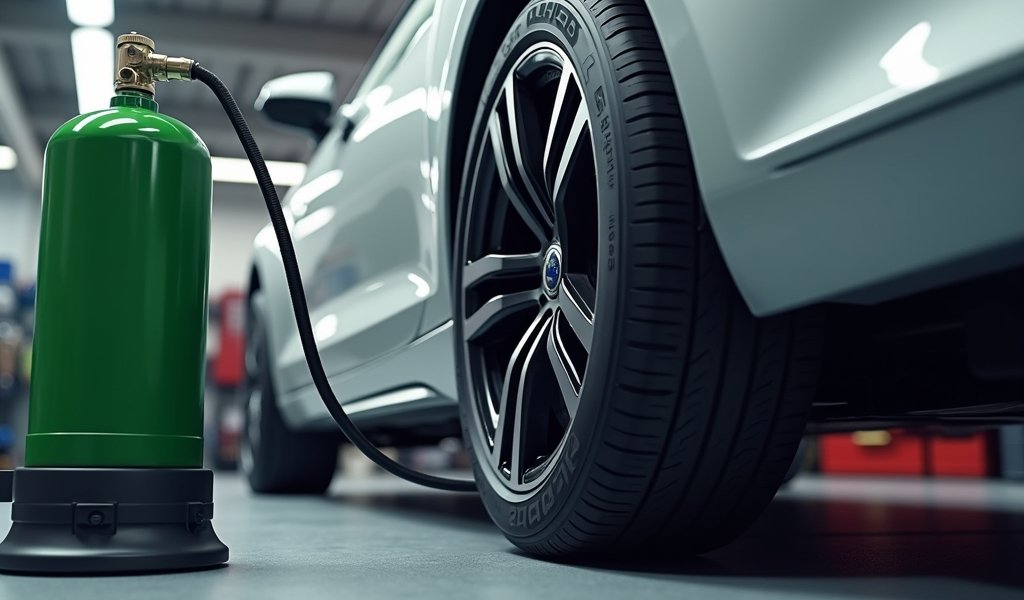Overview
This article explains how nitrogen tire inflation provides benefits over regular air by maintaining more stable tire pressure, improving fuel efficiency, extending tire life, and reducing maintenance frequency due to nitrogen’s larger molecular size and non-reactive properties. The author outlines five key tips for proper nitrogen implementation: correct transition procedures, optimal pressure maintenance, effective monitoring, seasonal considerations, and a cost-benefit analysis that suggests nitrogen inflation is worthwhile for most drivers despite the initial investment.
Table of Contents
- Understanding Nitrogen Tire Inflation
- The Science Behind Nitrogen in Tires
- Primary Benefits of Nitrogen Tire Inflation
- Tip 1: Proper Transition to Nitrogen-Filled Tires
- Tip 2: Maintaining Optimal Pressure Levels
- Tip 3: Monitoring Nitrogen-Filled Tires
- Tip 4: Seasonal Considerations
- Tip 5: Cost-Benefit Analysis
- Conclusion
- Frequently Asked Questions
Understanding Nitrogen Tire Inflation
As a seasoned mechanic who’s spent countless hours beneath hoods and beside wheel wells, I’ve witnessed firsthand how nitrogen tire inflation benefits can transform your driving experience. Picture this: your tires, those humble rubber rings that connect your prized vehicle to the pavement, silently determining everything from fuel efficiency to handling and safety. They’re the unsung heroes of the highway, yet many of us pay them little mind until trouble strikes.
The practice of filling tires with nitrogen instead of regular air isn’t just a passing trend or a premium service pitched by pushy service advisors. It’s a legitimate technical advancement that merits serious consideration. When we dive into the molecular differences between standard air and nitrogen, we discover a world of potential advantages that could extend tire life, improve performance, and even save you money in the long run.
Have you ever wondered why racing teams, airlines, and military vehicles have been using nitrogen in their tires for decades? The answer lies not in marketing hype but in measurable, scientific benefits. In this comprehensive guide, I’ll walk you through everything you need to know about nitrogen tire inflation, debunking myths while highlighting genuine advantages that might make a meaningful difference to your daily drive.
The Science Behind Nitrogen in Tires
To truly appreciate nitrogen tire inflation benefits, we need to peek beneath the surface at some fascinating molecular science. Regular air contains approximately 78% nitrogen, 21% oxygen, and a smattering of other gases, along with varying amounts of water vapor. When we talk about “nitrogen inflation,” we’re referring to purified nitrogen that typically reaches 93-98% concentration in your tires.
Why does this matter? The magic lies in the molecular size and behavior. Nitrogen molecules are larger than oxygen molecules, making them less likely to permeate through tire rubber. This microscopic difference creates a cascade of practical benefits for your vehicle. When oxygen and water vapor escape through tire walls (which happens constantly with regular air), your tire pressure drops, forcing you to refill more frequently.
Furthermore, oxygen inside your tires is reactive. Over time, it oxidizes the rubber from the inside out and corrodes metal components like your rims and valve stems. It’s a slow-motion assault on your tire’s internal structure. Think of oxygen as an uninvited dinner guest who not only eats your food but also scratches your furniture on the way out. Nitrogen, by comparison, is like the perfect houseguest—it stays put and doesn’t cause trouble.
According to research from the National Highway Traffic Safety Administration, maintaining proper tire pressure is critical for safety, and pressure loss is a common issue with standard air-filled tires. The molecular stability of nitrogen helps address this fundamental challenge in a way that regular air simply cannot match.

Primary Benefits of Nitrogen Tire Inflation
Now that we’ve established the scientific foundation, let’s explore the practical nitrogen tire inflation benefits that matter most to everyday drivers. These aren’t theoretical advantages—they’re real-world improvements I’ve observed in vehicles that make the switch.
Perhaps the most notable benefit is more stable tire pressure over time. Nitrogen-filled tires retain their pressure up to three to four times longer than those filled with regular air. This persistence isn’t just convenient—it’s a cornerstone of vehicle safety and performance. When you check your tires before a road trip, you’ll likely find nitrogen-filled tires have maintained their pressure more faithfully.
Consistent tire pressure translates directly to improved fuel efficiency. Studies by the U.S. Department of Energy indicate that properly inflated tires can improve gas mileage by up to 3%. That might seem modest, but across thousands of miles and years of driving, those savings accumulate like raindrops filling a bucket. In our era of volatile fuel prices, every efficiency gain counts.
The absence of moisture in nitrogen also means more predictable pressure changes as temperatures fluctuate. Regular air contains water vapor that expands dramatically when heated and contracts when cooled. This explains why your tire pressure warning light might illuminate on cold mornings but disappear once you’ve driven a while. Nitrogen-filled tires exhibit much smaller pressure variations between hot summer afternoons and frosty winter mornings.
Perhaps most significantly, nitrogen helps extend tire life by preventing internal oxidation and maintaining optimal inflation. The rubber compounds in modern tires are engineering marvels, but they’re still vulnerable to oxygen’s relentless degradation. By removing this threat, nitrogen helps your tires reach their full potential lifespan, potentially saving you hundreds of dollars in premature replacements.
Tip 1: Proper Transition to Nitrogen-Filled Tires
Transitioning to nitrogen isn’t as simple as adding some nitrogen to your existing air-filled tires. For maximum nitrogen tire inflation benefits, a proper purging process is essential. When I guide customers through this transition, I emphasize that half-measures yield half-results.
The correct procedure begins with completely deflating your tires. This initial purge removes the majority of existing air. Next, a technician should inflate the tire with nitrogen to approximately 30 PSI, then deflate it again. This cycle should be repeated at least three times to achieve a nitrogen concentration of 93% or higher. Anything less negates many of the benefits we’re seeking.
I recommend requesting a nitrogen purity test after the service. Many shops have analyzers that can verify the nitrogen concentration in your newly filled tires. Don’t be shy about asking—you’re paying for a premium service and deserve confirmation it’s been performed correctly. A professional shop will welcome this request rather than viewing it as a challenge.
Some drivers wonder if they need to replace their valve stems during this transition. While not strictly necessary, I often suggest green nitrogen-specific valve caps. These aren’t just for show—they help identify which tires contain nitrogen (useful for service technicians) and provide an additional seal against leakage. These small investments enhance the system’s overall effectiveness.
Remember that all four tires (plus your spare, if applicable) should be converted simultaneously. Mixing nitrogen and air-filled tires creates unpredictable handling characteristics that could compromise safety in emergency maneuvers. Consistency across all tires ensures the balanced performance your vehicle’s engineers designed.
Tip 2: Maintaining Optimal Pressure Levels
A common misconception is that nitrogen-filled tires never need pressure checks. While nitrogen dramatically reduces the frequency of pressure adjustments, it doesn’t eliminate them entirely. Environmental factors, small leaks, and seasonal temperature changes still affect nitrogen-filled tires—just less dramatically than their air-filled counterparts.
I advise my customers to check nitrogen tire pressure monthly rather than the weekly checks recommended for conventional tires. This reduced maintenance schedule is one of the practical nitrogen tire inflation benefits that busy drivers appreciate most. You’ll spend less time at the air pump but still ensure your tires remain within optimal pressure ranges.
What pressure should you maintain? The answer isn’t “the maximum pressure printed on the tire sidewall”—a mistake I see frequently. Instead, locate the manufacturer’s recommended pressure, typically found on a placard in your driver’s door jamb or owner’s manual. This specification balances ride comfort, handling, tread wear, and fuel efficiency for your specific vehicle.
If you need to top off a nitrogen-filled tire and don’t have access to a nitrogen source, it’s perfectly acceptable to use regular air in a pinch. The small amount of air added won’t significantly dilute the nitrogen concentration. When convenient, return to your nitrogen provider for a proper top-off, but never risk driving with dangerously low pressure just to maintain nitrogen purity.
For ultimate convenience, consider investing in a quality portable tire inflator that can travel with you. This backup solution ensures you’re never stranded with low tire pressure, regardless of your filling medium. Some advanced models even include preset pressure functions that automatically stop at your desired PSI level.

Tip 3: Monitoring Nitrogen-Filled Tires
Modern vehicles come equipped with Tire Pressure Monitoring Systems (TPMS) that alert drivers when tire pressure falls below safe levels. These electronic guardians provide an additional safety net, but they’re not meant to replace regular pressure checks. Understanding how to reset your tire pressure monitoring system after making pressure adjustments is a valuable skill for any driver.
One monitoring advantage with nitrogen is fewer false TPMS alerts. Since nitrogen pressure remains more stable during temperature changes, you’ll experience fewer warning lights on cold mornings or after heat-soaked highway drives. This consistency means when your TPMS light does illuminate, it’s more likely signaling a genuine issue requiring attention.
Beyond electronic monitoring, develop the habit of visually inspecting your tires regularly. Look for signs of uneven wear, which might indicate alignment issues that nitrogen can’t solve. Check for bulges, cuts, or embedded objects that could lead to failure. Even the most perfectly inflated tire can’t overcome physical damage.
Keep a log of your tire pressure readings over time. This simple practice reveals patterns that might otherwise go unnoticed. If one tire consistently loses pressure faster than the others, it likely has a slow leak that needs addressing regardless of whether you’re using nitrogen or conventional air.
According to tire experts at Tire Rack, monitoring is particularly important during the first few weeks after switching to nitrogen. This initial period reveals whether the purging process was effective and if your tires maintain pressure as expected with their new nitrogen fill.
Tip 4: Seasonal Considerations
Seasonal temperature swings present significant challenges for tire pressure management. Standard air-filled tires typically lose 1-2 PSI for every 10°F drop in temperature. While nitrogen-filled tires still experience pressure changes with temperature fluctuations, these variations are less dramatic—perhaps the most practical of all nitrogen tire inflation benefits for drivers in variable climates.
As autumn gives way to winter’s grip, pay special attention to your tire pressure. Even with nitrogen, the extreme temperature differentials of winter may require occasional adjustments. The smaller adjustments needed with nitrogen make this seasonal maintenance less burdensome but don’t eliminate it entirely.
Summer presents its own challenges. Searing pavement temperatures combined with friction-generated heat from driving create tire pressure increases that can affect handling. Nitrogen’s stability helps minimize these fluctuations, providing more consistent performance even during temperature extremes that would cause significant pressure changes in air-filled tires.
When transitioning between winter tires and all-season or summer tires, ensure both sets receive the nitrogen treatment. This consistency maintains the benefits year-round and prevents confusion about which tires contain which inflation medium. If budget constraints limit you, prioritize nitrogen for the tire set that sees the most extreme temperature variations in your climate.
Remember that seasonal tire rotations remain essential even with nitrogen-filled tires. Nitrogen improves many aspects of tire performance but doesn’t eliminate the need for basic maintenance procedures that ensure even wear and maximum tire life.
Tip 5: Cost-Benefit Analysis
Let’s address the elephant in the room: nitrogen tire inflation costs more than conventional air, which is typically free or nearly so at most service stations. Initial nitrogen filling costs between $5-$10 per tire at most service centers, with some dealers offering lifetime top-offs with purchase. Is this premium worth the investment? The answer depends on your driving habits and priorities.
For high-mileage drivers, the fuel efficiency improvements alone may justify the cost. If nitrogen helps maintain optimal pressure, potentially improving mileage by 3%, a driver covering 15,000 annual miles in a vehicle averaging 25 MPG could save approximately 18 gallons of fuel yearly. At $3.50 per gallon, that’s $63 annual savings—easily covering the initial nitrogen investment.
Tire longevity provides another economic benefit. Premium tires represent a significant investment, often costing $150-$300 each. If nitrogen inflation extends tire life by even 10% through reduced oxidation and more consistent pressure, the savings on a set of four tires could reach $60-$120 per replacement cycle.
Consider also the convenience factor. Fewer pressure checks and adjustments save time—a resource often more valuable than money. For busy professionals or those who don’t enjoy vehicle maintenance, this convenience has tangible value beyond dollar figures.
The environmental calculus deserves consideration too. Extended tire life means fewer discarded tires in landfills. Improved fuel efficiency translates to reduced carbon emissions. While individual impacts may seem small, collectively they contribute to transportation sustainability, as noted by EPA recommendations on tire maintenance.
My advice? View nitrogen as an investment rather than an expense. For most drivers who keep their vehicles for several years, the cumulative benefits typically outweigh the upfront costs, particularly for those who value performance consistency and reduced maintenance.
Conclusion
Nitrogen tire inflation benefits represent a perfect intersection of science and practical application. From the molecular differences that prevent air leakage to the real-world advantages of consistent pressure, extended tire life, and improved fuel efficiency, nitrogen offers tangible improvements over conventional inflation methods. While not a miracle solution that eliminates all tire maintenance, it significantly reduces the frequency and severity of pressure-related issues.
As with any automotive technology, the decision to adopt nitrogen inflation should be informed by your specific circumstances. High-mileage drivers, owners of premium vehicles, and those who value consistency and reduced maintenance will likely find the greatest return on investment. Casual drivers with older vehicles might find the benefits less compelling relative to the initial cost.
What’s undeniable is that proper tire inflation—whether with nitrogen or conventional air—remains one of the most important yet overlooked aspects of vehicle maintenance. Your tires are literally where the rubber meets the road, affecting everything from safety to efficiency. If nitrogen helps you maintain optimal pressure with less effort, that alone may justify the investment.
Remember that nitrogen complements but doesn’t replace regular tire inspections and maintenance. Even the most perfectly inflated tire can’t overcome alignment issues, suspension problems, or physical damage. View nitrogen as one component of a comprehensive tire care strategy, not a complete solution in isolation.
After two decades working with vehicles of all types, I’ve seen technology fads come and go. Nitrogen inflation has demonstrated staying power because it delivers measurable benefits backed by sound science. For drivers seeking practical ways to enhance performance, extend tire life, and reduce maintenance frequency, nitrogen remains one of the most accessible and effective options available.
Frequently Asked Questions
Can I mix nitrogen with regular air in my tires?
Yes, you can mix them, but doing so dilutes the benefits of nitrogen. For optimal results, purge your tires completely before filling with nitrogen to achieve at least 93% concentration.
How much does nitrogen tire inflation cost?
Initial nitrogen filling typically costs $5-$10 per tire at most service centers. Many shops offer free or discounted refills for returning customers who purchased the initial service.
Will nitrogen prevent flat tires?
No, nitrogen won’t prevent punctures or valve stem failures that cause flat tires. It reduces gradual pressure loss through tire walls but can’t stop air loss from physical damage.
How do I know if my tires have nitrogen?
Tires filled with nitrogen often have green valve stem caps instead of black ones. You can also ask your service provider to test the nitrogen concentration with a specialized analyzer.
Is nitrogen inflation worth it for all vehicles?
Nitrogen provides the greatest benefits for vehicles driven frequently, premium vehicles with expensive tires, and in climates with extreme temperature variations. The cost-benefit analysis varies based on your specific driving habits and vehicle.

